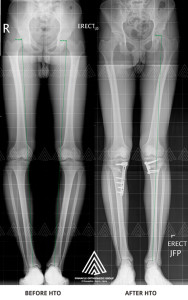After Osteotomy Surgery Care

In most cases, patients stay at the hospital for 1-2 days after a knee osteotomy. During this time, you will be monitored and given pain medication.
After the operation, your surgeon may put your knee in a brace or cast for protection while the bone heals.
You will most likely need to use crutches for several weeks.
About 6 weeks after the operation, you will see your surgeon for a follow-up visit. X-rays will be taken so that your surgeon can check how well the osteotomy has healed. After the follow-up, your surgeon will tell you when it is safe to put weight on your leg, and when you can start rehabilitation.
During rehabilitation, a physical therapist will give you exercises to help maintain your range of motion and restore your strength.
You may be able to resume your full activities after 3 to 6 months.
Complications
As with any surgical procedure, there are risks involved with osteotomy. Your surgeon will discuss each of the risks with you and will take specific measures to help avoid potential complications.
Although the risks are low, the most common complications include:
- Infection
- Blood clots
- Stiffness of the knee joint
- Injuries to vessels and nerves
- Failure of the knee osteotomy to heal
In some cases, a second surgery may be required, particularly if the osteotomy does not heal.
Combining HTO With Cartilage Repair Procedures
Increasingly, Dr Lee is combining HTO with cartilage repair procedures to treat younger patients with arthritis affecting one side of the knee. Most of these patients Dr Lee sees usually have had previous sports injuries some time ago with injuries to the meniscus or cartilage on one side of the knee and are now suffering from arthritis (widespread damage of cartilage) in that particular side of the knee.
In these patients, besides cartilage damage, they also have malalignment of their lower limbs with excessive weight going through the damaged part of the knee. If we just perform a cartilage repair procedure without correcting this malalignment, the repair will fail. Thus in such patients, my choice would be to do an arthroscopic keyhole cartilage repair procedure (usually microfracture with a Chondrogide or Hyalofast graft) followed by an opening wedge HTO. The HTO will correct the alignment of the lower limb, shifting weight to the unaffected half of the knee, thus protecting my cartilage repair.
Conclusion
Osteotomy can relieve pain and delay the progression of arthritis in the knee. It can allow a younger patient to lead a more active lifestyle for many years. Even though many patients will ultimately require a total knee replacement, an osteotomy can be an effective way to buy time until a replacement is required.
Looking For A Reliable Knee Orthopaedic Specialist?
Fast Medical Attention, Transparent Fees
Make an appointment for comprehensive care for your knee problems!
